How Long Does Waffle Batter Last in the Fridge
Your waffle batter will typically last 2-3 days in the refrigerator when stored properly at 40°F (4.4°C) or below in an airtight container. Store-bought liquid batters can stay fresh for 7-10 days after opening, while dry mixes remain good for months until mixed with wet ingredients. You'll want to store your batter in the main compartment of your fridge, not the door, and leave about an inch of headspace in the container. Watch for signs of spoilage like off-putting odors, discoloration, or mold. Following proper storage techniques can help you maximize your batter's shelf life and guarantee the best possible waffles.
This post may contain affiliate links. If you make a purchase through these links, I may earn a commission at no additional cost to you. Additionally, portions of this post may be generated using artificial intelligence (AI) technology. While we strive for accuracy, please be aware that AI-generated content may not always be perfect and should be fact-checked when necessary.
The Spatula Scoops
- Homemade waffle batter typically lasts 2-3 days when stored properly in an airtight container at 40°F or below.
- Store-bought liquid waffle batter remains fresh for 7-10 days after opening when kept refrigerated.
- Store batter in the middle shelf of the refrigerator, avoiding door storage to maintain consistent temperature.
- Check for signs of spoilage like sour smells, color changes, or mold before using refrigerated batter.
- Use clean utensils each time you access the batter to prevent contamination and extend shelf life.
Basic Storage Guidelines

Anyone can store waffle batter in the refrigerator, but proper storage is essential for food safety and quality. You'll need to transfer your batter into an airtight container, leaving about an inch of headspace to account for any expansion. Make sure you're using a container that's clean, dry, and specifically designed for food storage.
When you're ready to store your batter, you'll want to label the container with the date you made it. Place the container toward the back of your fridge, where the temperature remains most consistent, typically between 35-38°F (1.7-3.3°C). Don't store it in the door, as temperature fluctuations there can affect the batter's stability.
If you've made batter with fresh ingredients, you should seal it immediately after mixing. For best results, you'll want to place a piece of plastic wrap directly on the batter's surface before securing the container's lid. This prevents a skin from forming and reduces the risk of oxidation. Remember to use clean utensils each time you access the stored batter to prevent contamination.
Understanding Waffle Batter Ingredients
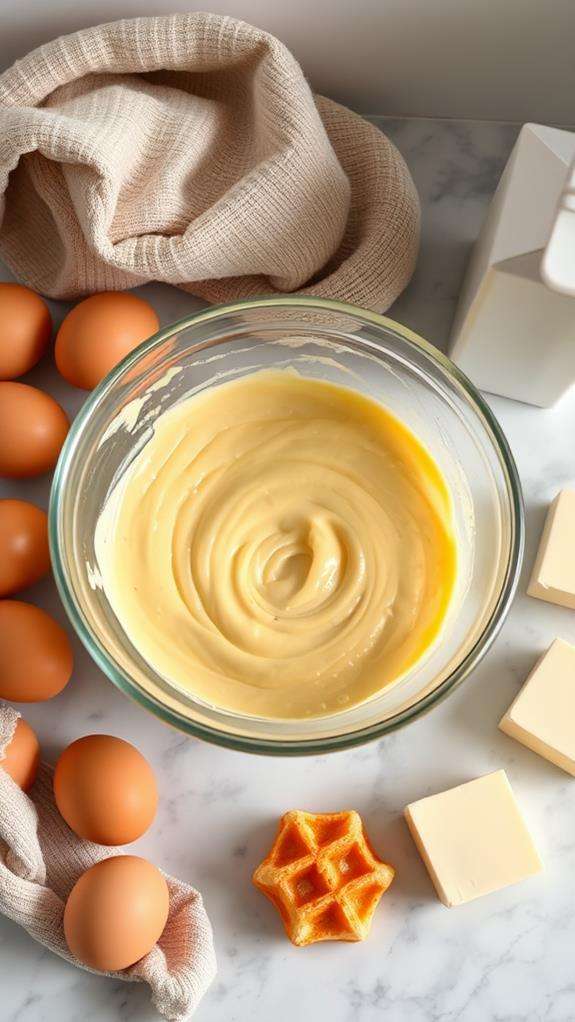
The shelf life of your waffle batter depends largely on what goes into it. Typical waffle batter contains several perishable ingredients, including eggs, milk, and butter, which greatly impact how long you can safely store the mixture. These dairy components are usually the first elements to show signs of spoilage.
Your batter's dry ingredients, such as flour, sugar, baking powder, and salt, don't pose storage concerns on their own. However, once they're combined with wet ingredients, bacterial growth becomes possible. If you're using buttermilk in your recipe, you'll need to be especially vigilant, as it's more prone to spoilage than regular milk. The presence of raw eggs in your batter creates additional food safety considerations, as they can harbor salmonella bacteria if not properly refrigerated.
You'll also want to reflect on any add-ins you've incorporated into your batter. Fresh fruits, nuts, or chocolate chips can affect storage time differently. Fresh fruit, in particular, can introduce additional moisture and natural sugars that may accelerate spoilage. If you've added vanilla extract or other flavorings, these typically won't impact storage time greatly due to their alcohol content.
Signs of Spoilage
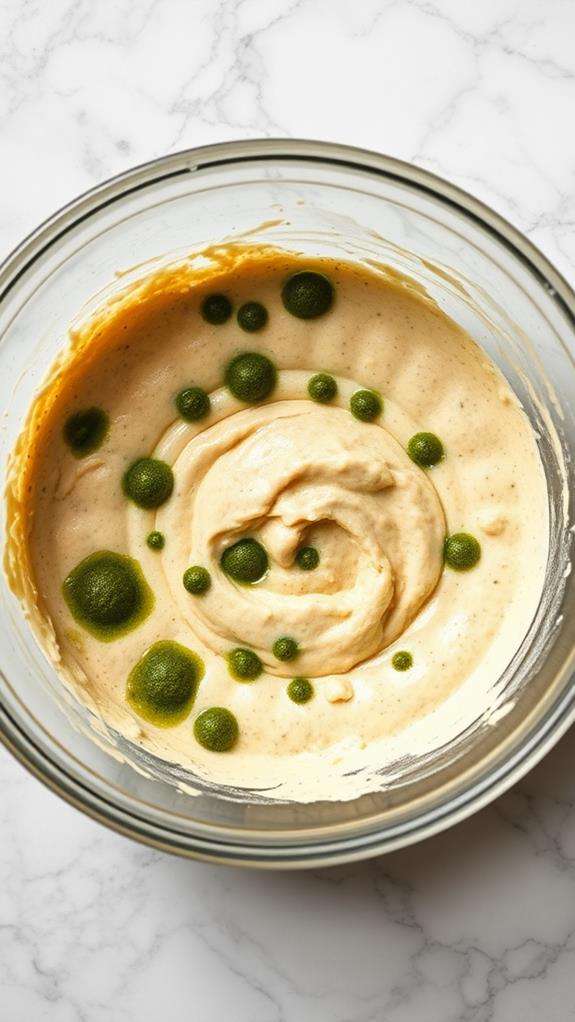
Four key signs indicate your waffle batter has spoiled: an off-putting sour smell, discoloration, mold growth, and separation that won't remix. When examining your batter, you'll want to trust your senses, particularly your nose, as fermentation produces distinctive acidic odors that signal spoilage.
Color changes serve as another essential indicator. Your once-creamy batter shouldn't develop any of these warning signs:
- Gray, green, or bluish tints appearing on the surface
- Dark spots that weren't present when you first made the batter
- Yellow or brownish discoloration throughout the mixture
If you notice the liquid and solid components separating, try giving it a gentle stir. While some separation is normal during storage, spoiled batter won't properly reincorporate, often leaving stubborn lumps or an uneven consistency. When mold appears, you'll typically spot fuzzy patches in various colors, most commonly white, green, or black. These patches might start small but can quickly spread throughout the batter. Don't attempt to salvage spoiled batter by removing visible mold – microscopic spores have likely contaminated the entire mixture, making it unsafe for consumption.
Proper Storage Methods
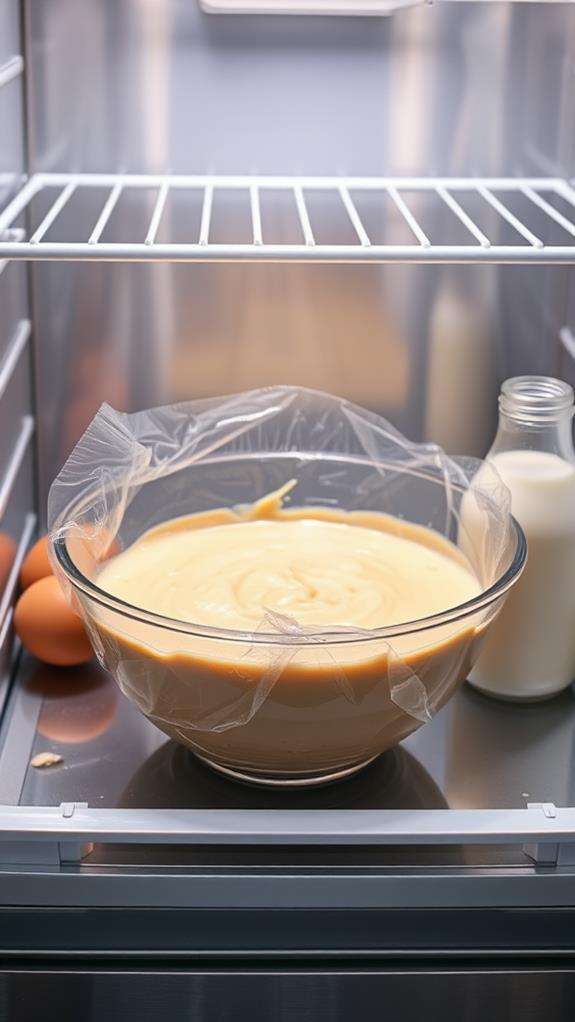
To keep your waffle batter fresh for as long as possible, you'll need to store it in a clean, airtight container that's specifically designed for liquid storage, such as a mason jar with a tight-fitting lid or a food-grade plastic container with a snap-lock seal. You'll want to maintain a consistent refrigerator temperature between 35-38°F (1.6-3.3°C), checking regularly with a refrigerator thermometer to guarantee ideal storage conditions. Position your batter container on a middle shelf of your refrigerator, away from the door and raw ingredients, to prevent temperature fluctuations that could affect its longevity.
Airtight Container Selection
Selecting proper airtight containers stands as your first line of defense against waffle batter spoilage. When choosing your storage container, you'll want to focus on containers that offer a complete seal while being appropriate for your batch size. Glass or BPA-free plastic containers with snap-on or screw-top lids work best, as they prevent both oxidation and potential refrigerator odors from affecting your batter.
For ideal storage results, consider these essential container characteristics:
- Air-tight silicone or rubber gaskets that create a complete seal when closed
- Clear or semi-transparent material that allows you to check batter condition without opening
- Containers with wide mouths for easy pouring and cleaning
You'll need to guarantee your container has enough headspace to account for any minimal expansion that might occur during storage. A container that's too full could lead to overflow or compromise the seal's effectiveness. If you're storing multiple batches, consider using portion-sized containers rather than one large vessel. This approach minimizes exposure to air each time you need to use the batter and helps maintain freshness throughout your storage period.
Temperature Control Tips
Maintaining proper temperature control stands essential for extending your waffle batter's shelf life in the refrigerator. You'll want to keep your refrigerator's temperature between 35°F and 38°F (1.7°C to 3.3°C), as this range effectively inhibits bacterial growth while preserving the batter's consistency. Make sure you've got a reliable refrigerator thermometer to monitor these conditions.
Place your batter container on a middle shelf, where the temperature remains most consistent. Avoid storing it in the door compartments, as these areas experience frequent temperature fluctuations every time you open the fridge. When you're removing the batter for use, don't let it sit at room temperature for more than 30 minutes, as this can promote bacterial growth and affect the leavening agents' effectiveness.
If you notice any temperature issues with your refrigerator, such as inconsistent cooling or frost buildup, address these problems promptly. You can also create a designated "cold zone" in your fridge by keeping the batter away from heat-producing items like leftover hot foods or items that are frequently accessed. This strategic placement helps maintain ideal storage conditions for your waffle batter.
Safe Refrigerator Placement
Proper container selection plays an essential role in storing your waffle batter safely. You'll want to place your batter container in the best spot within your refrigerator to maintain its freshness and prevent cross-contamination. The middle shelf of your fridge, where the temperature typically stays most consistent, offers the ideal storage location.
When choosing your refrigerator placement, consider these critical factors:
- Keep the batter away from raw meats to prevent bacterial cross-contamination
- Store containers at least 1 inch apart to allow proper air circulation
- Position the container where it won't be jostled or knocked over during regular fridge access
You'll need to verify your batter container isn't placed too close to the refrigerator's cooling vents, as this can cause partial freezing and affect the batter's consistency. The door shelves aren't suitable for waffle batter storage due to temperature fluctuations every time you open the fridge. If you're using multiple containers, arrange them in a single layer rather than stacking to maintain even cooling. This placement strategy helps preserve the batter's quality while maximizing its shelf life through proper temperature control and organization.
Extending Shelf Life
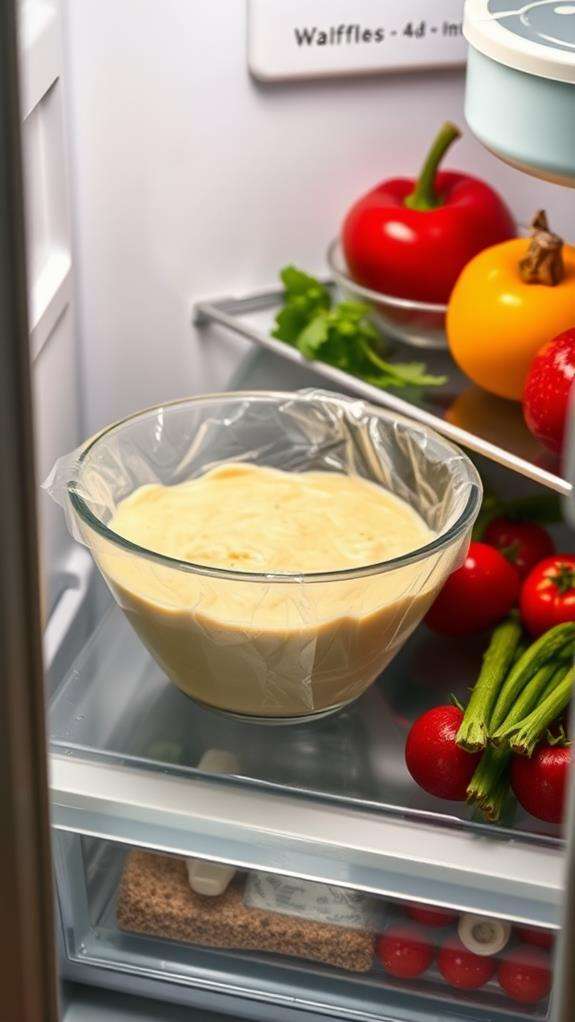
To extend your waffle batter's shelf life, you'll need airtight, BPA-free containers with secure lids that prevent both oxidation and absorption of refrigerator odors. Maintaining consistent temperature control is essential, so store your batter in the main body of your refrigerator at 38-40°F (3-4°C), not in the door where temperatures fluctuate frequently. For maximum freshness, consider dividing your batter into smaller portions using multiple containers, which reduces the number of times you'll expose the entire batch to room temperature when using it.
Proper Storage Containers
Airtight containers serve as your waffle batter's best defense against spoilage in the refrigerator. When selecting your storage solution, you'll want to choose containers that create a proper seal to prevent both oxidation and cross-contamination from other foods' odors.
For prime storage of your waffle batter, consider these essential container characteristics:
- Glass or BPA-free plastic containers with snap-on or screw-top lids that create an airtight seal
- Containers with minimal headspace to reduce air exposure and prevent bacterial growth
- Transparent or semi-transparent materials that allow you to inspect the batter without opening
You'll find that wide-mouth containers work particularly well, as they make it easier to pour and scoop the batter without creating a mess. If you're storing multiple batches, consider using stackable containers to maximize your refrigerator space. Remember to label your container with the date you made the batter, using either a permanent marker or adhesive label. Don't fill the container more than 3/4 full, as the batter might expand slightly due to the leavening agents continuing to work even at cooler temperatures.
Temperature Control Tips
Maintaining consistent temperature control is essential for maximizing your waffle batter's shelf life. You'll want to keep your refrigerator at or below 40°F (4°C), which is the ideal temperature zone for preserving fresh batter while preventing harmful bacterial growth.
Don't place your batter container near the refrigerator door, as this area experiences frequent temperature fluctuations when you open and close it. Instead, position it on the middle shelf, where temperatures remain more stable. If you're storing multiple containers, ascertain they're not stacked directly against each other, as this can create warm spots between the containers.
Monitor your refrigerator's temperature using a dedicated thermometer, and check it daily to guarantee consistent cooling. If you notice temperature variations exceeding 5°F, you may need to adjust your refrigerator's settings or have it serviced. When removing batter for use, work quickly to minimize its exposure to room temperature, and never leave it out for more than 30 minutes. If your kitchen is particularly warm (above 75°F), reduce this time to 20 minutes to prevent premature fermentation and bacterial growth.
Homemade Vs Store-Bought
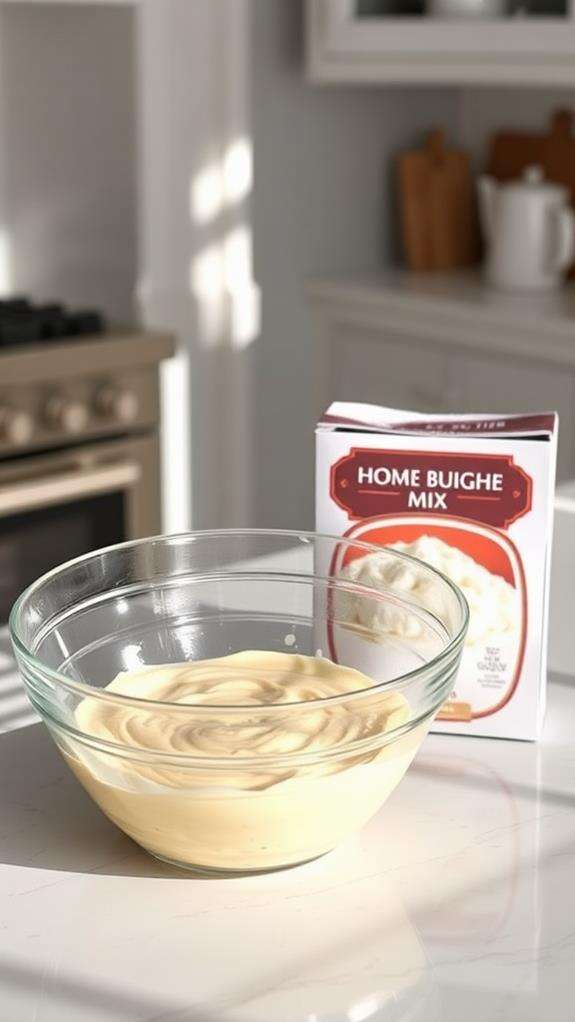
Waffle-mix storage differs considerably between homemade and store-bought varieties. When you're working with homemade batter, you'll need to be more cautious about storage time since it contains fresh ingredients like eggs and milk that can spoil quickly. Store-bought mixes, which often contain preservatives and stabilizers, typically maintain their quality longer.
You'll notice these key differences in shelf life between the two types:
- Homemade batter typically lasts 2-3 days when properly refrigerated at 40°F (4°C)
- Store-bought liquid batter can last 7-10 days after opening
- Dry store-bought mix stays fresh for months if kept sealed and dry
If you're using store-bought mix, you'll want to check the "best by" date and follow the manufacturer's storage instructions carefully. Once you've added wet ingredients to a dry mix, treat it like homemade batter. Remember that store-bought versions often contain ingredients like sodium acid pyrophosphate and other stabilizers that extend shelf life, while your homemade version relies solely on basic ingredients without preservation aids.
Freezing Your Batter
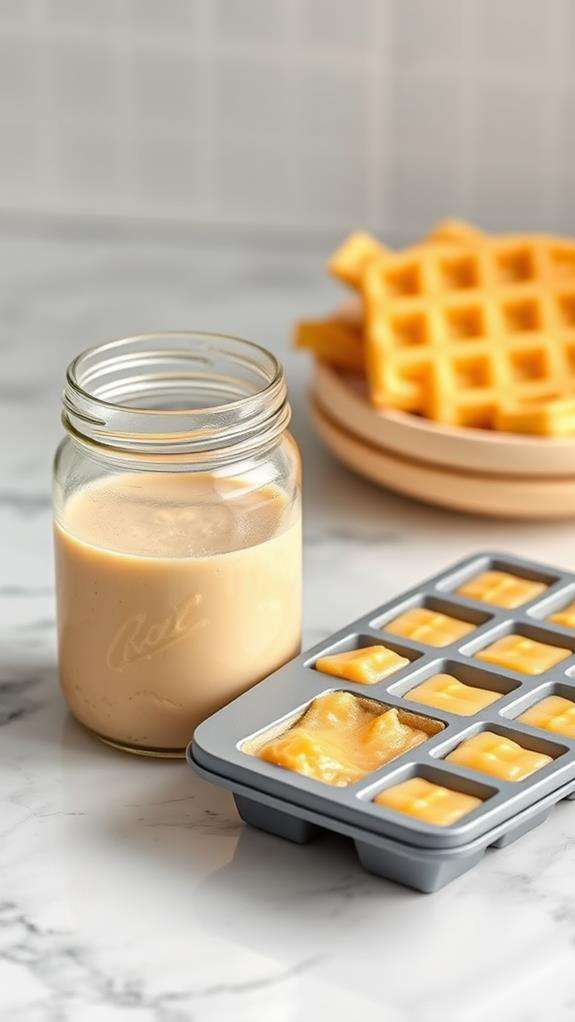
Storing your waffle batter in the freezer can extend its life by up to 3 months. To freeze your batter effectively, you'll need to transfer it into an airtight, freezer-safe container, leaving about an inch of headspace to allow for expansion. It's crucial to label your container with the date you're freezing the batter to track its freshness.
When you're ready to use your frozen batter, you'll need to plan ahead. Transfer the container to your refrigerator and let it thaw overnight, which typically takes 8-12 hours. Once thawed, you'll notice the mixture may have separated slightly. Don't worry – this is normal. Simply whisk the batter thoroughly to recombine all ingredients before using. If you find the consistency too thick, you can thin it out with a small amount of milk.
For best results, don't refreeze previously frozen batter. Instead, consider freezing your batter in smaller portions using multiple containers or freezer bags. This way, you can thaw only what you need, reducing waste and maintaining the best possible texture for your waffles.
Safety and Quality Tips
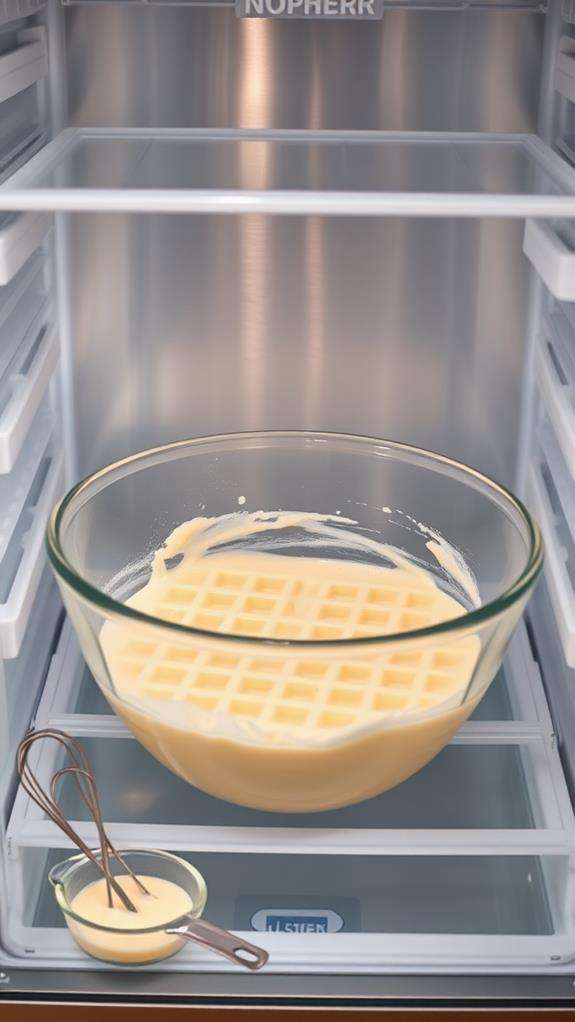
For ideal food safety, you'll need to follow several key practices when storing waffle batter. Always use an airtight container and verify your refrigerator maintains a consistent temperature below 40°F (4.4°C). Check that your batter hasn't developed any off-putting odors, unusual discoloration, or mold before using it.
To maintain the highest quality and safety standards, implement these essential practices:
- Store your batter in the main compartment of your refrigerator, not in the door where temperature fluctuations occur
- Label your container with the date you made the batter and its expected expiration date
- Use clean utensils each time you portion out batter to prevent cross-contamination
When you're ready to use refrigerated batter, let it reach room temperature for 15-20 minutes, then give it a gentle stir to recombine any separated ingredients. If you notice any bubbling, fermentation smell, or gray-green discoloration, discard the batter immediately. Don't taste questionable batter to test its safety – when in doubt, throw it out. Remember that even properly stored batter will gradually lose its leavening power, resulting in denser waffles over time.
Frequently Asked Questions
Can I Use Waffle Batter as Pancake Batter?
Did you know that waffles and pancakes share about 90% of the same basic ingredients? You can definitely use waffle batter for pancakes, but you'll notice some differences. Waffle batter typically contains more sugar and fat than pancake batter, which means your pancakes will be sweeter and potentially crispier. If you're going to use waffle batter, try thinning it slightly with milk to achieve that classic pancake consistency.
Does Adding Fruit to Waffle Batter Affect Refrigeration Time?
Yes, adding fruit to your waffle batter will reduce its refrigeration time. Fresh fruits introduce extra moisture and natural sugars that can speed up fermentation and bacterial growth. You'll want to use fruit-containing batter within 24-36 hours, compared to 2-3 days for plain batter. If you're using berries or citrus, their acidic nature can also affect the batter's leavening agents over time, potentially impacting your waffles' texture.
Should Waffle Batter Rest Before Cooking?
You should let your waffle batter rest for 15-30 minutes before cooking. This resting period serves two key purposes: it allows the flour's gluten to relax, which prevents tough waffles, and it gives time for the baking powder to start working. If you're using yeast in your recipe, you'll need a longer rest time of about 1-2 hours to let the yeast develop properly.
Can I Make Belgian Waffles With Refrigerated Batter?
Yes, you can make Belgian waffles with refrigerated batter, and it might even improve your results. When you're ready to cook, let the cold batter sit at room temperature for 15-20 minutes to take the chill off. You'll want to stir it gently to redistribute any settled ingredients. If your batter's too thick after refrigeration, you can thin it with a small amount of milk until it reaches the right consistency.
Does Altitude Affect How Long Waffle Batter Stays Fresh?
You'd think altitude wouldn't matter for waffle batter storage, but it actually does. At higher elevations (above 3,000 feet), the lower air pressure can slightly accelerate bacterial growth and fermentation in your batter. You'll want to reduce storage time by about 25% compared to sea level recommendations. For example, if your batter typically lasts 48 hours at sea level, plan to use it within 36 hours at high altitude.





